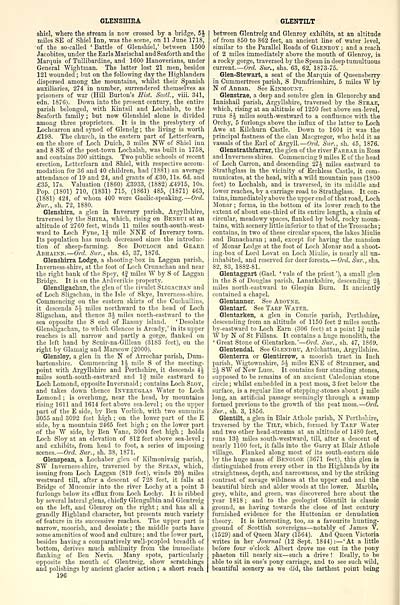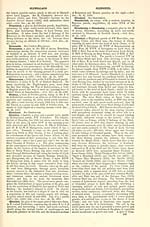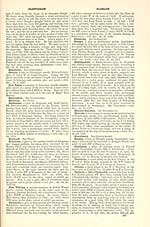Ordnance gazetteer of Scotland > Volume 3
(266) Page 196
Download files
Complete book:
Individual page:
Thumbnail gallery: Grid view | List view

GLENSHIRA
sbiel, where the stream is now crossed by a bridge, BJ
mUes SE of Shiel Inn, was the scene, on 11 June 1718,
•of the so-called 'Battle of Glenshiel,' between 1500
Jacobites, under the Earls Marischal andSeaforth and the
Marquis of TuUibardine, and 1600 Hanoverians, under
General Wightman. The latter lost 21 men, besides
121 wounded; but on the following day the Highlanders
dispersed among the mountains, whilst their Spanish
auxiliaries, 274 in number, surrendered themselves as
prisoners of war (Hill Burton's Hist. ScotL, viii. 341,
edn. 1876). Down into the present century, the entire
parish belonged, with Kintail and Lochalsh, to the
Seaforth family ; but now Glenshiel alone is divided
among three proprietors. It is in the presbytery of
Lochcarron and synod of Glenelg ; the living is worth
£198. The church, in the eastern part of Letterfearn,
on the shore of Loch Duich, 3 miles NW of Shiel inn
and 8 SE of the post-town Lochalsh, was built in 1758,
and contains 300 sittings. Two public schools of recent
erection, Letterfearn and Shiel, with respective accom-
modation for 36 and 40 children, had (1881) an average
attendance of 19 and 24, and grants of £30, lis. 6d. and
£35, 17s. Valuation (1860) £3933, (1882) £4915, 10s.
Pop. (ISOl) 710, (1831) 715, (1861) 485, (1871) 463,
(1881) 424, of whom 400 were Gaelic-speaking. — Ord.
Sur., sh. 72, 1880.
Glenshira, a glen in Inverary parish, Argyllshire,
traversed by the Shira, which, rising on Ben'BUI at an
altitude of 2760 feet, winds 11 miles south-south-west-
ward to Loch Fyne, IJ mile NNE of Inverary town.
Its population has much decreased since the introduc-
tion of sheep-farming. See Doulooh and Geare
Abhainn.— Ocd Sur., shs. 45, 37, 1876.
Glenshirra Lodge, a shooting-box in Laggan parish,
Inverness-shire, at the foot of Loch Crunachan and near
the right bank of the Spey, 4f miles W by S of Laggan
Bridge. It is on the Ardverikie property.
Glensligachan, the glen of the rivulet Sligachan and
of Loch Sligachan, in the Isle of Skye, Inverness-shire.
Commencing on the eastern skirts of the Cuchullins,
it descends Si miles northward to the head of Loch
Sligachan, and thence 3J miles north-eastward to the
sea opposite the S end of Baasay island. ' Desolate
Glensligachan, to which Glencoe is Arcady, ' in its upper
reaches is all narrow and partly a gorge, flanked on
the left hand by Scuir-na-Gillean (3183 feet), on the
right by Glamaig and Marscow (2000).
Glensloy, a glen in the N of Arrochar parish, Dum-
bartonshire. Commencing IJ mile S of the meeting-
point with Argyllshire and Perthshire, it descends 4^
miles south-south-eastward and 1§ mile eastward to
Loch Lomond, opposite luversnaid ; contains Loch Sloy,
and takes down thence Inveruglas Water to Loch
Lomond ; is overhung, near the head, by mountains
rising 1611 and 1614 feet above sea-level ; on the upper
part of the E side, by Ben Vorlich, with two summits
3055 and 3092 feet high ; on the lower part of the E
side, by a mountain 2465 feet high ; on the lower part
of the W side, by Ben Vane, 3004 feet high ; holds
Loch Sloy at an elevation of 812 feet above sea-level ;
and exhibits, from head to foot, a series of imposing
scenes. — Ord. Sur., sh. 38, 1871.
Glenspean, a Lochaber glen of Kilmonivaig parish,
SW l:iverness-shire, traversed by tlie Spean, which,
issuing from Loch Laggan (819 feet), winds 20-J miles
westward till, after a descent of 728 feet, it falls at
Bridge of Mucomir into the river Lochy at a point 3
furlongs below its efflux from Loch Lochy. It is ribbed
by several lateral glens, chiefly Glengulbin and Glentreig
on the left, and Glenroy on the right ; and has all a
grandly Highland character, but presents much variety
of feature in its successive reaches. The upper part is
narrow, moorish, and desolate ; the middle parts have
some amenities of wood and culture ; and the lower part,
besides having a comparatively we'1-pcopled breadth of
bottom, derives much sublimity from the immediate
flanking of Ben Nevis. Many spots, particularly
opposite the mouth of Glentreig, show scratchings
and polishings by ancient glacier action ; a short reach
196
GLENTILT
between Glentreig and Glenroy exhibits, at an altitude
of from 850 to 862 feet, an ancient line of water level,
similar to the Parallel Roads of Glenroy ; and a reach
of 2 miles immediately above the month of Glenroy, is
a rocky gorge, traversed by the Spean in deep tumultuous
current.— Or(^. Sur., shs. 63, 62, 1873-75.
Glen-Stewart, a seat of the Marquis of Queensberry
in Cummertrees parish, S Dumfriesshire, 5 miles W by
N of Annan. See Kinmount.
Glenstrae, a deep and sombre glen in Glenorchy and
Innishail parish, Argyllshu-e, traversed by the Strae,
which, rising at an altitude of 1250 feet above sea-level,
runs 8J miles south-westward to a confluence with the
Orchy, 5 furlongs above the influx of the latter to Loch
Awe at Kilchurn Castle. Down to 1604 it was the
principal fastness of the clan Macgregor, who held it as
vassals of the Earl of Argyll. — Ord. Sur., sh. 45, 1876.
Glenstrathfarrar, the glen of the river Farrar in Ross
and Inverness shires. Commencing 9 miles E of the head
of Loch Carron, and descending 27| miles eastward to
Strathglass in the vicinity of Erchless Castle, it com-
municates, at the head, with a wild moimtain pass (1800
feet) to Lochalsh, and is traversed, in its middle and
lower reaches, by a carriage road to Strathglass. It con-
tains, immediately above the upper end of that road. Loch
Monar ; forms, in the bottom of its lower reach to the
extent of about one-third of its entire length, a chain of
cii'cular, meadowy spaces, flanked by bold, rocky moim-
tains, with scenery little inferior to that of the Trossachs ;
contains, in two of these circular spaces, the lakes Miulie
and Bunacharan ; and, except for having the mansion
of Monar Lodge at the foot of Loch Monar and a shoot-
ing-box of Lord Lovat on Loch Miulie, is nearly all un-
inhabited, and reserved for deer forests. — Ord. Sur., shs.
82, 83, 1882-81.
Glentaggart (Gael. ' vale of the priest '), a small glen
in the S of Douglas parish, Lanarkshire, descending 2J
miles north-eastward to Glespin Burn. It anciently
contained a chapel.
Glentanner. See Abotnb.
Glentarf. See Tarf Water.
Glentarken, a glen in Comrie parish, Perthshire,
descending from an altitude of 1150 feet 2 miles south-
by-eastward to Loch Earn (306 feet) at a point IJ mile
W by N of St Fillans. It contains a huge monolith, the
' Great Stone of Glentarken.'— Ore?. Sur., sh. 47, 1869.
Glentendal. See Glendhu, Ardchattan, Argyllshire.
Glenterra or Glentirrow, a moorish tract in Inch
parish, AVigtownshii'e, 5 J miles ENE of Stranraer, and
2J SW of New Luce. It contains four standing stones,
supposed to be remains of an ancient Caledonian stone
circle ; whilst embedded in a peat moss, 3 feet below the
sm'face, is a regular line of stepping-stones about ^ mile
long, an artificial passage seemingly through a swamp
formed previous to the growth of the peat moss. — Ord.
Sur., sh. 3, 1856.
Glentilt, a glen in Blair Athole parish, N Perthshire,
traversed by the Tilt, which, formed by Tare Water
and two other head-streams at an altitude of 1480 feet,
runs 13 J miles south-westward, till, after a descent of
nearly 1100 feet, it falls into the Garry at Blair Athole
village. Flanked along most of its south-eastern side
by the huge mass of Bekgloe (3671 feet), this glen is
distinguished from every other in the Highlands by its
straightness, depth, and narrowness, and by the striking
contrast of savage wildness at the upper end and the
beautiful bii'ch and alder woods at the lower. Marble,
grey, white, and green, was discovered here about the
year 1818 ; and to the geologist Glentilt is classic
ground, as having towards the close of last century
furnished evidence for the Huttonian or denudation
theory. It is interesting, too, as a favourite hunting-
ground of Scottish sovereigns — notably of James V.
(1529) and of Queen Mary (1564). And Queen Victoria
writes in her Journal (12 Sept. 1844): — 'At a little
before four o'clock Albert drove me out in the pony
phaeton till nearly six — such a drive ! Really, to be
able to sit in one's pony carriage, and to see such wild,
beautiful scenery as we did, the farthest point being
sbiel, where the stream is now crossed by a bridge, BJ
mUes SE of Shiel Inn, was the scene, on 11 June 1718,
•of the so-called 'Battle of Glenshiel,' between 1500
Jacobites, under the Earls Marischal andSeaforth and the
Marquis of TuUibardine, and 1600 Hanoverians, under
General Wightman. The latter lost 21 men, besides
121 wounded; but on the following day the Highlanders
dispersed among the mountains, whilst their Spanish
auxiliaries, 274 in number, surrendered themselves as
prisoners of war (Hill Burton's Hist. ScotL, viii. 341,
edn. 1876). Down into the present century, the entire
parish belonged, with Kintail and Lochalsh, to the
Seaforth family ; but now Glenshiel alone is divided
among three proprietors. It is in the presbytery of
Lochcarron and synod of Glenelg ; the living is worth
£198. The church, in the eastern part of Letterfearn,
on the shore of Loch Duich, 3 miles NW of Shiel inn
and 8 SE of the post-town Lochalsh, was built in 1758,
and contains 300 sittings. Two public schools of recent
erection, Letterfearn and Shiel, with respective accom-
modation for 36 and 40 children, had (1881) an average
attendance of 19 and 24, and grants of £30, lis. 6d. and
£35, 17s. Valuation (1860) £3933, (1882) £4915, 10s.
Pop. (ISOl) 710, (1831) 715, (1861) 485, (1871) 463,
(1881) 424, of whom 400 were Gaelic-speaking. — Ord.
Sur., sh. 72, 1880.
Glenshira, a glen in Inverary parish, Argyllshire,
traversed by the Shira, which, rising on Ben'BUI at an
altitude of 2760 feet, winds 11 miles south-south-west-
ward to Loch Fyne, IJ mile NNE of Inverary town.
Its population has much decreased since the introduc-
tion of sheep-farming. See Doulooh and Geare
Abhainn.— Ocd Sur., shs. 45, 37, 1876.
Glenshirra Lodge, a shooting-box in Laggan parish,
Inverness-shire, at the foot of Loch Crunachan and near
the right bank of the Spey, 4f miles W by S of Laggan
Bridge. It is on the Ardverikie property.
Glensligachan, the glen of the rivulet Sligachan and
of Loch Sligachan, in the Isle of Skye, Inverness-shire.
Commencing on the eastern skirts of the Cuchullins,
it descends Si miles northward to the head of Loch
Sligachan, and thence 3J miles north-eastward to the
sea opposite the S end of Baasay island. ' Desolate
Glensligachan, to which Glencoe is Arcady, ' in its upper
reaches is all narrow and partly a gorge, flanked on
the left hand by Scuir-na-Gillean (3183 feet), on the
right by Glamaig and Marscow (2000).
Glensloy, a glen in the N of Arrochar parish, Dum-
bartonshire. Commencing IJ mile S of the meeting-
point with Argyllshire and Perthshire, it descends 4^
miles south-south-eastward and 1§ mile eastward to
Loch Lomond, opposite luversnaid ; contains Loch Sloy,
and takes down thence Inveruglas Water to Loch
Lomond ; is overhung, near the head, by mountains
rising 1611 and 1614 feet above sea-level ; on the upper
part of the E side, by Ben Vorlich, with two summits
3055 and 3092 feet high ; on the lower part of the E
side, by a mountain 2465 feet high ; on the lower part
of the W side, by Ben Vane, 3004 feet high ; holds
Loch Sloy at an elevation of 812 feet above sea-level ;
and exhibits, from head to foot, a series of imposing
scenes. — Ord. Sur., sh. 38, 1871.
Glenspean, a Lochaber glen of Kilmonivaig parish,
SW l:iverness-shire, traversed by tlie Spean, which,
issuing from Loch Laggan (819 feet), winds 20-J miles
westward till, after a descent of 728 feet, it falls at
Bridge of Mucomir into the river Lochy at a point 3
furlongs below its efflux from Loch Lochy. It is ribbed
by several lateral glens, chiefly Glengulbin and Glentreig
on the left, and Glenroy on the right ; and has all a
grandly Highland character, but presents much variety
of feature in its successive reaches. The upper part is
narrow, moorish, and desolate ; the middle parts have
some amenities of wood and culture ; and the lower part,
besides having a comparatively we'1-pcopled breadth of
bottom, derives much sublimity from the immediate
flanking of Ben Nevis. Many spots, particularly
opposite the mouth of Glentreig, show scratchings
and polishings by ancient glacier action ; a short reach
196
GLENTILT
between Glentreig and Glenroy exhibits, at an altitude
of from 850 to 862 feet, an ancient line of water level,
similar to the Parallel Roads of Glenroy ; and a reach
of 2 miles immediately above the month of Glenroy, is
a rocky gorge, traversed by the Spean in deep tumultuous
current.— Or(^. Sur., shs. 63, 62, 1873-75.
Glen-Stewart, a seat of the Marquis of Queensberry
in Cummertrees parish, S Dumfriesshire, 5 miles W by
N of Annan. See Kinmount.
Glenstrae, a deep and sombre glen in Glenorchy and
Innishail parish, Argyllshu-e, traversed by the Strae,
which, rising at an altitude of 1250 feet above sea-level,
runs 8J miles south-westward to a confluence with the
Orchy, 5 furlongs above the influx of the latter to Loch
Awe at Kilchurn Castle. Down to 1604 it was the
principal fastness of the clan Macgregor, who held it as
vassals of the Earl of Argyll. — Ord. Sur., sh. 45, 1876.
Glenstrathfarrar, the glen of the river Farrar in Ross
and Inverness shires. Commencing 9 miles E of the head
of Loch Carron, and descending 27| miles eastward to
Strathglass in the vicinity of Erchless Castle, it com-
municates, at the head, with a wild moimtain pass (1800
feet) to Lochalsh, and is traversed, in its middle and
lower reaches, by a carriage road to Strathglass. It con-
tains, immediately above the upper end of that road. Loch
Monar ; forms, in the bottom of its lower reach to the
extent of about one-third of its entire length, a chain of
cii'cular, meadowy spaces, flanked by bold, rocky moim-
tains, with scenery little inferior to that of the Trossachs ;
contains, in two of these circular spaces, the lakes Miulie
and Bunacharan ; and, except for having the mansion
of Monar Lodge at the foot of Loch Monar and a shoot-
ing-box of Lord Lovat on Loch Miulie, is nearly all un-
inhabited, and reserved for deer forests. — Ord. Sur., shs.
82, 83, 1882-81.
Glentaggart (Gael. ' vale of the priest '), a small glen
in the S of Douglas parish, Lanarkshire, descending 2J
miles north-eastward to Glespin Burn. It anciently
contained a chapel.
Glentanner. See Abotnb.
Glentarf. See Tarf Water.
Glentarken, a glen in Comrie parish, Perthshire,
descending from an altitude of 1150 feet 2 miles south-
by-eastward to Loch Earn (306 feet) at a point IJ mile
W by N of St Fillans. It contains a huge monolith, the
' Great Stone of Glentarken.'— Ore?. Sur., sh. 47, 1869.
Glentendal. See Glendhu, Ardchattan, Argyllshire.
Glenterra or Glentirrow, a moorish tract in Inch
parish, AVigtownshii'e, 5 J miles ENE of Stranraer, and
2J SW of New Luce. It contains four standing stones,
supposed to be remains of an ancient Caledonian stone
circle ; whilst embedded in a peat moss, 3 feet below the
sm'face, is a regular line of stepping-stones about ^ mile
long, an artificial passage seemingly through a swamp
formed previous to the growth of the peat moss. — Ord.
Sur., sh. 3, 1856.
Glentilt, a glen in Blair Athole parish, N Perthshire,
traversed by the Tilt, which, formed by Tare Water
and two other head-streams at an altitude of 1480 feet,
runs 13 J miles south-westward, till, after a descent of
nearly 1100 feet, it falls into the Garry at Blair Athole
village. Flanked along most of its south-eastern side
by the huge mass of Bekgloe (3671 feet), this glen is
distinguished from every other in the Highlands by its
straightness, depth, and narrowness, and by the striking
contrast of savage wildness at the upper end and the
beautiful bii'ch and alder woods at the lower. Marble,
grey, white, and green, was discovered here about the
year 1818 ; and to the geologist Glentilt is classic
ground, as having towards the close of last century
furnished evidence for the Huttonian or denudation
theory. It is interesting, too, as a favourite hunting-
ground of Scottish sovereigns — notably of James V.
(1529) and of Queen Mary (1564). And Queen Victoria
writes in her Journal (12 Sept. 1844): — 'At a little
before four o'clock Albert drove me out in the pony
phaeton till nearly six — such a drive ! Really, to be
able to sit in one's pony carriage, and to see such wild,
beautiful scenery as we did, the farthest point being
Set display mode to: Large image | Transcription
Images and transcriptions on this page, including medium image downloads, may be used under the Creative Commons Attribution 4.0 International Licence unless otherwise stated. ![]()
| Gazetteers of Scotland, 1803-1901 > Ordnance gazetteer of Scotland > Volume 3 > (266) Page 196 |
|---|
| Permanent URL | https://digital.nls.uk/97379646 |
|---|
| Attribution and copyright: |
|
|---|---|

